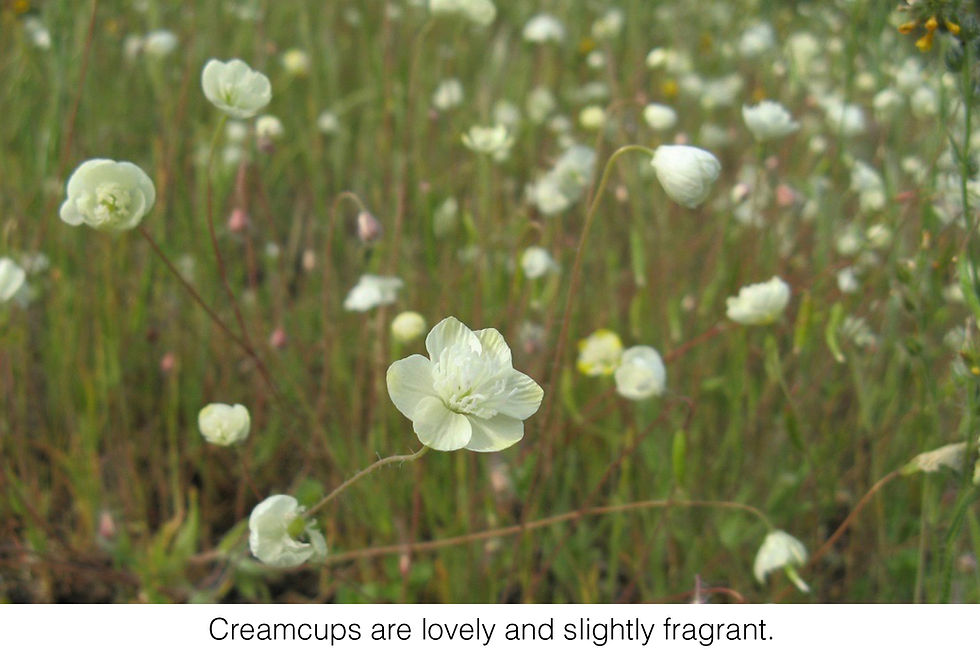GOING WILD WITH NATIVES: Annual Wildflowers
- Rachel Cobb

- Mar 1, 2018
- 3 min read

By Linda Jones:
This time of year is usually the time to plan a walk—through your garden or to a natural area—to enjoy the colorful wildflowers. Often forgotten or overlooked for use in gardens are the annual native wildflowers that put on a relatively brief burst of color in spring. And all too frequently now, the burst of bright color we see on the hillsides is the invasive black mustard rather than the native flowers.
Annual wildflowers are the ultimate drought-tolerant plants. They lay dormant as seeds until the winter rains. Then they quickly sprout, grow, burst into bloom, and then go to seed when the soil dries up and the rains are gone for the year. The seeds tolerate the hot, dry summers just fine, and then the rains start the cycle again.
One difference between non-native plants and our annual native wildflowers is their availability. Nurseries are filled with blooming plants in every season—plants that are bred just to entice us into buying and planting them to brighten up our gardens all year. These plants are specially bred to have a long blooming season, are hearty enough that anyone can successfully grow them with enough water. Then next season you can replace them with a new crop of specially bred plants.
Not the case with our native annuals. These plants are geared towards being dormant through the summer. So nurseries cannot grow plants for you to pop into your garden in each season. Some nurseries, like Tree of Life Nursery, provide a few potted plants you can add to the garden but supply is limited. If you want to grow these lovely annual wildflowers you'll generally need to plant seeds. The good news is that once successfully planted, they are likely to reseed year after year, making a bright spot in your garden each spring.
To grow wildflowers, you can order packets of mixed seeds from native plant nurseries, and you can even request a special mix of seed if you want certain species. Some of the nurseries that carry seeds for native annuals are Tree of Life Nursery, S&S Seeds, Annie's Annuals and Perennials, and Larner Seeds.
Alternatively, you could also collect seeds of plants you want to grow. This is a gardening adventure unto itself. The important part of this process is to find the flowers in bloom and mark them with a colorful flag to locate them when it is time to harvest the seeds. Otherwise, good luck finding that gorgeous plant you saw last spring. And get out to harvest them before they are eaten by wildlife. (Note: If you want to collect on public lands, you will probably need a permit, so check before you collect.)
Seeds are best planted in the fall. To spread out the blooming season, plant new seeds several weeks apart. In normal years, you can (mostly) rely on the winter rains to germinate the seeds; in drought years, give them some help with occasional watering. After they grow and beautify your spring garden, leave the plants in place until they die. Tree of Life Nursery's Mike Evans recommends trampling on the dead plants to release the seeds. Then leave it all in place! The organic material will naturally enrich the soil. For tall plants, shake the seeds out onto the planting area and remove the tall stalks. Trample the rest and pat yourself on the back for your excellent gardening practices. When the rains come, the seeds will germinate and—voilà! You will soon have a spot of spring color to brighten your garden. And native pollinators will appreciate your work to bring these lovely wildflowers into your garden.

Annuals come in a variety of shapes and sizes. Two of my favorites are creamcups (Platystemon californicus) and Chinese houses (Collinsia heterophylla; photo on left). The latter may be included in packets of annual seeds; the first is more difficult to find and you may have to collect these seeds.
The lovely and slightly fragrant creamcups, a member of the poppy family, have one-inch blossoms on twelve-inch-high plants. From nodding seed pods to bloom, these are pretty garden additions. Chinese houses add lovely purple blooms on taller stems.
Go and enjoy the annual wildflowers of spring, wherever you can find them!
